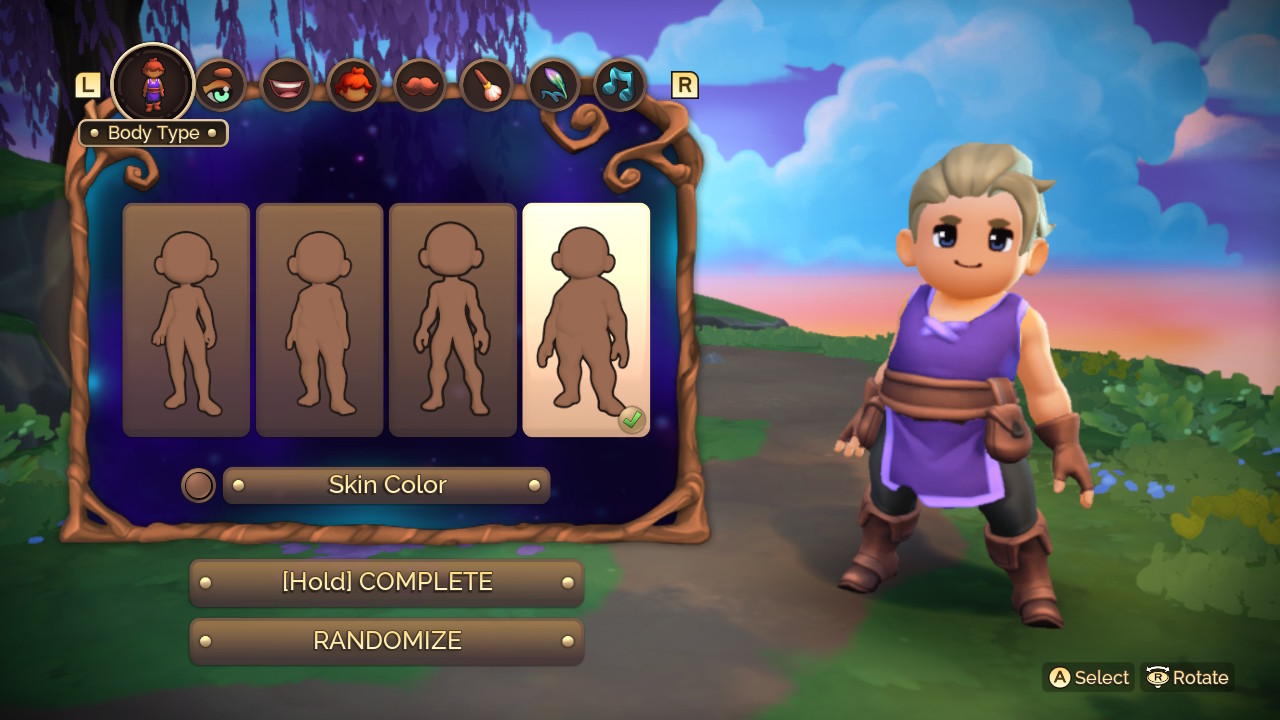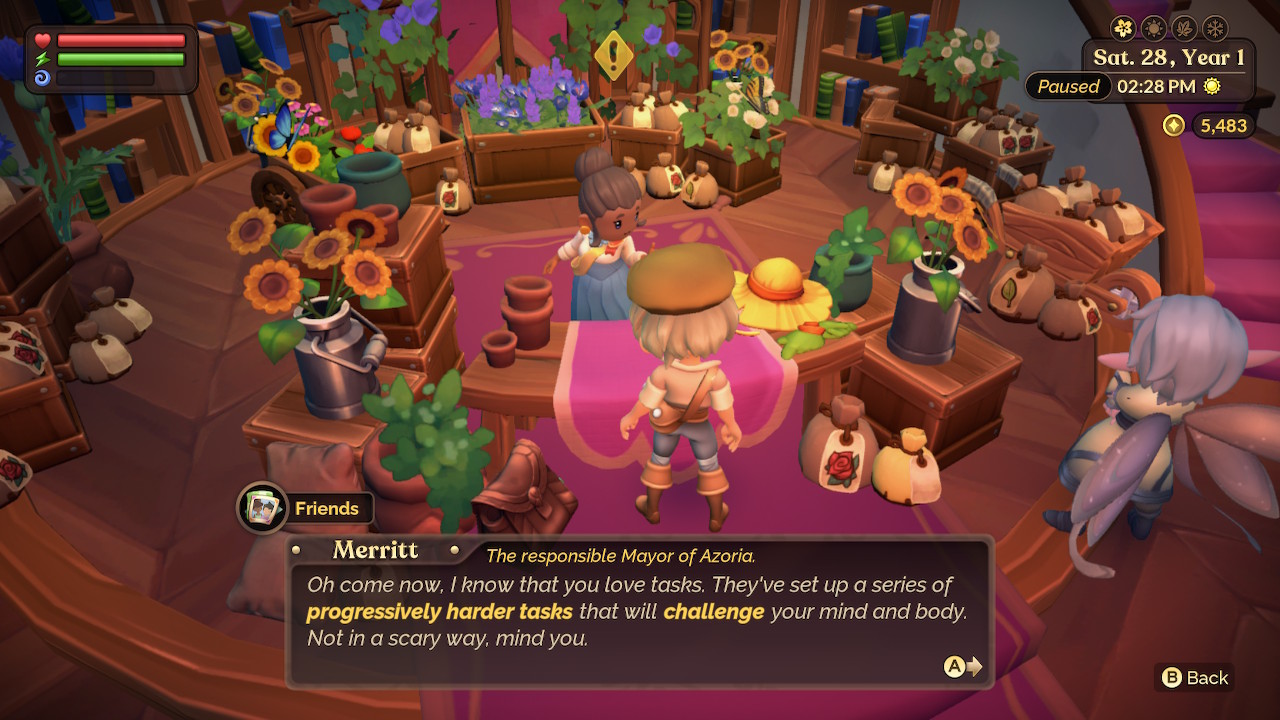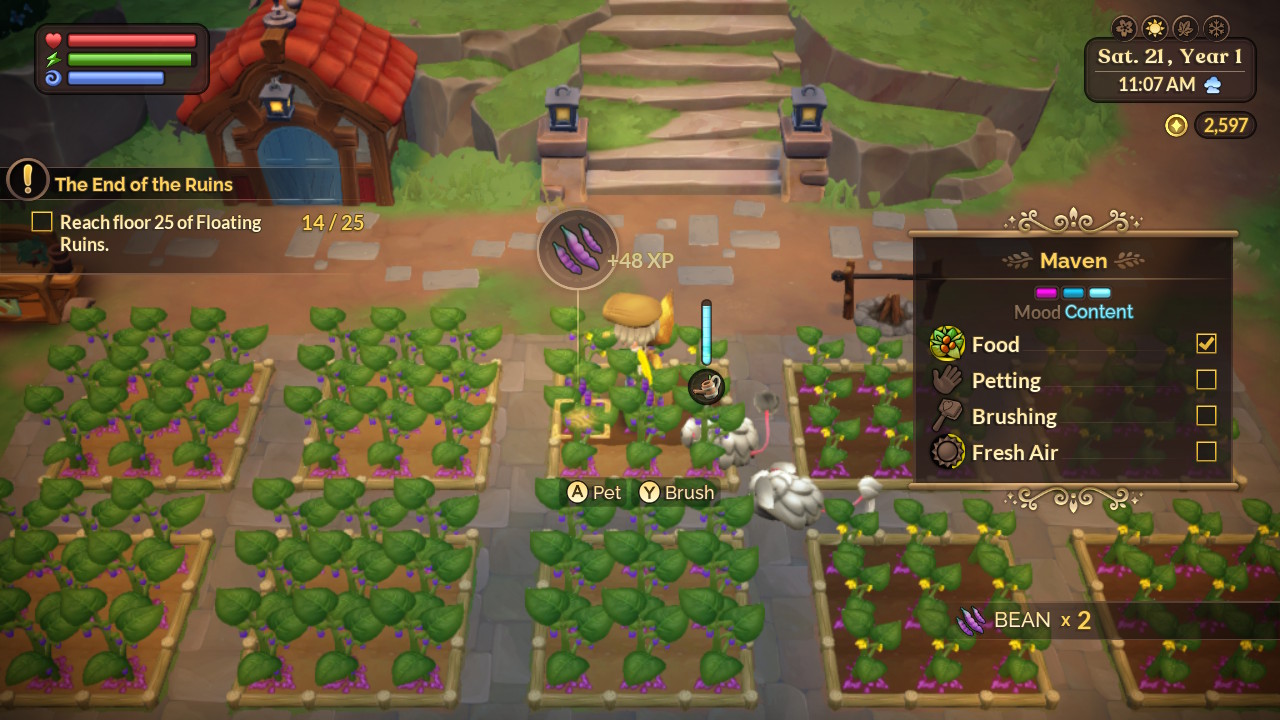Fae Farm, developed and published by Phoenix Labs, is a farming life-sim dungeon-crawling hybrid and reminds me that we need a new genre name. Since the advent of the farming sim genre with the original Harvest Moon, straight through to the beloved Stardew Valley, simply calling these games “farming sims” was fine. You knew what to expect. And while Stardew Valley did have several dungeons, and as fleshed-out as they were both in design and gameplay, they weren’t the game’s primary focus. However, the genre continues to evolve. Fae Farm is proof of that, bringing much more focus to the dungeon spelunking side of things than I think is even present in the Rune Factory series.
Fae Farm‘s title screen opens to some adorable artwork that perfectly reflects the vibe of the game as a whole. I was surprised by the need to create a Phoenix Labs account — presumably for cross-multiplay purposes — though it only takes moments to complete. One thing to consider is that your account name is also your character’s name and cannot be changed, even if you create characters of different genders down the line. Weirdly enough, my name “Sam” was censored due to profanity, but “Sam-James” was just fine.
The character creation options in Fae Farm aren’t as intricate as some modern games, but I appreciated the different body type options (something sorely lacking across all gaming genres) and the diverse options for skin tones, hair colour, voices, and pronouns were all very welcome. I find it more immersive to make characters that look like me in games like this, so kudos to the devs for making that possible for people who aren’t as generic-looking as myself. And thus, with our alter-egos fully formed and adorable, we venture onto the island of Azoria.
The opening segment of Fae Farm unfolds as a tutorial, providing some story context without being insultingly hand-holdy. Many of the features present are similar to other games of the genre, which might lead to the assumption that there aren’t any unique features. However, discovering you can free-fall off cliffs, swim in all bodies of water, fill your watering can up while swimming (and in the rain!), and all manner of other small details will be a refreshing surprise to farming sim veterans. The controls can feel a little floaty, but given that you can eventually gain access to wings that let you double-jump for even more height and travel, it feels appropriate to have a little bit of float to your travel. The movement doesn’t sacrifice much accuracy despite feeling floaty, so you can still land jumps without much frustration.
It’s not long before you gain access to all the features of your first farm. As you progress through Fae Farm and unlock further territories, you’ll unlock more farm space and a wider variety of animals and crops. Aside from the actual brick-and-mortar buildings, such as your house and barn, everything you place will be crafted from an ever-expanding catalogue of items. Want to plant crops? Drop down plots of any shape and pattern you choose. Don’t have the materials? Go smash some rocks and dig up some dirt. It feels rewarding to gather a new item for the first time, as it will unlock every recipe in your almanac that uses said item as a material. Not only does this allow you to see what you can currently craft, but it also gives you the wanderlust to get out there to see what you can find and what new crafting recipes they will unlock. You’ll also find recipes scattered around the island, encouraging you to jump and swim around to uncover every little… nook and cranny. We reference other popular cozy games at RPGFan! Thank you.
Farm work itself is surprisingly simple, but it makes sense when you see how intrinsic it is to pretty much everything else in the game. Synergy seems to be an important design philosophy in Fae Farm. Including Farming, there are ten different skills to utilise and level up. Activities such as Logging, Foraging, Potion Brewing, and Critter Catching will gain experience every time you perform an associated action. Progressing through the 20 levels of each skill will open up tool upgrades, proficiency bonuses, and higher gathering yields.
Back to farming. Seeds are mostly a static list of Turnips, Cauliflower, and Beans, with Potato, Corn, and Pepper seeds unlocking as you level your Farming skill. Putting a spin on things, Fae Farm lets you purchase fertilisers that alter crops to either alternative seasonal variants (for example, multi-harvestable Beans will become Pumpkins in the Fall) or Fae variants, which you can refine into Potion Brewing ingredients. I genuinely like this system; it means you don’t need to worry about what crops are available to purchase in which season, and it was a lot of fun experimenting with the different fertilisers to see what transformations are possible. There are no progression levels for crop quality, so what you plant is what you get, but this rings true across all gatherable items regardless of their source.
Unfortunately, my farming experience was marred by quite a few bugs. During my review period, the area of effect watering can skill was flat-out broken and didn’t water anything. This meant that, regardless of how big my farm was and how many crops I was growing, I still had to painstakingly water each plot individually. Further frustration was brought about by my livestock wandering around; the keybinds for the watering can AoE skill and its standard single-tile function are the same as the Pet, Brush, Milk, Shear, etc. actions for livestock. Your animals actively seek you out while roaming the farm, which often meant I’d mistakenly pet a Chickoo ad nauseam instead of watering my precious Turnip. You can’t manually move your animals by picking them up or pushing them, and, despite the affection boost from petting and brushing only applying once a day, the option does not grey out once performed. It became cumbersome and stress-inducing to perform these tasks daily. There’s some other jank associated with animals, such as them being able to walk through each other while also not having the option to toggle which animal is targeted, thus potentially repeating the same action on the same animal. Animals will also sometimes literally just absorb each other in reverse mitosis. I’m not clever enough to know if there’s a term for that. A mercy is that there seems to be no downside to simply ignoring your animals aside from putting feed in their troughs. I’m hoping some of these issues are addressed in patches, and it’s important to note that the watering can area of effect skill was already fixed by the time I wrote this, though most of my time spent with the game was with a broken watering can.
While farming may seem like the most essential task in a farming game, I’d argue that dungeoneering takes the cake for overall priority. Fae Farm’s story progression and things like mining and the availability of tool upgrades are all tied to dungeons. There are three in total, each with different themes, progression mechanics, enemies, and gatherable materials. I enjoyed my dungeon time at first; you can teleport to any floor you want to if you’ve crafted a succession of warp keys, and this made it easy to find whatever specific material I needed. Unfortunately, things started to sour for me towards the middle of the second dungeon, and only got more taxing from there. Now, I’m all for difficulty in games. I love it when items have an actual purpose and when a bit of planning saves my bacon. However, as I mentioned before, Fae Farm loves its synergy, to the point where it feels artificially enforced to give items and gameplay systems more worth.
The first dungeon was nice and straightforward; I appreciated that. It reminded me of the mines in Stardew Valley but with its own flavour. The second requires that you use a specific potion every time you wish to enter, or you’ll pass out and get kicked out of the dungeon. The potions last for several in-game hours — but not all day — so you’ll need to have at least two on you to last in the dungeon for a day. It was not a massive chore in the second dungeon, as the ingredients for the required potion can be obtained from inside it. However, and my lip curls while remembering this, but there is a particular ingredient required for both the third dungeon’s requisition potion and… healing potions. The damage you take from enemies ramps up a lot at this point, so you shouldn’t have to choose between being able to enter or being defeated before you’ve made any worthwhile progress. And the ingredient? Frog Sweat. I wish I were joking. You have to run around Azoria catching frogs to make these potions. It sounds cute in concept, but when they aren’t that common to find and can run away quite easily, simply making the potions you need to enter the dungeon can be a chore.
Some of you may be thinking, “Healing potions? Tank and spank, baby!” or however humans convey reckless negligence these days, but you have very few defensive options against monsters. Jumbles, as the denizens of the dungeons are known, are inanimate objects brought to life by magic and banished for the island’s residents’ safety. Cute in concept, beautiful in design, but sometimes overly annoying in execution. Later in the game, it’s very easy to get swarmed by Jumbles, and with no evade ability or even animation cancelling, it became more than a nuisance to die while mining because I couldn’t cancel out or actively dodge an approaching horde. I mentioned earlier in the review that movement is floaty; this unfortunately applies to your string of melee attacks. Exploring the island in a floaty manner is fine, but getting stuck in a succession of un-cancellable attacks and getting hit by an AoE attack is not. Phoenix Labs’ answer seems to be “craft more potions!”, as there is quite an impressive array of craftable swiggables, but they should not come at the cost of basic combat actions.
One of the only parts of Fae Farm that isn’t as deep as I’d have liked is the cast of characters. The residents of Azoria are quite a varied bunch visually and personality-wise, but that’s kind of all they are. Other games in the genre will have you learn more about their characters by talking to them every day, but Fae Farm’s characters don’t have much new dialog past some commentary on story developments. Characters will thank you for clearing out the island’s thorn problem and make similar small talk as you progress the story, but it rings a tad hollow. Residents are divided into either Friendships or Romances, and you’ll only do one or the other with your given options. I enjoyed Galan’s story around his work with Jumbles, so it’s not like there’s no character development to speak of; it just isn’t at the forefront. I appreciated the lack of pressure to run around gifting everyone on the island daily, as I think that’s a dated mechanic that doesn’t promote genuine friendships.
Fae Farm can be a very enjoyable experience. Its graphics are gorgeous with a cohesive theme, its orchestrated music is beautiful, and all its gameplay systems have substance. The issue is that the game seems to trip over itself as things get more complex. I had more fun in the early-game dungeon than I did in the end-game dungeon, and if the game doesn’t get more fun as you progress, then what’s the point? I had some frustrations with animal care, which made me neglect them, so they became simple 3D models I gathered materials from daily and ensured they had food. Yet, while I had these gripes, the game is undeniably charming and compelling.
Fae Farm can flip-flop from feeling new, fresh, and polished to an Early Access title that needs some refining, but if Phoenix Labs has the resources to follow up with post-release patches, they could address every qualm I have. None of these things would require a total overhaul, or to be thrown out and started again from scratch. It’s things like balancing enemy damage, capping the number of times an animal can be interacted with per day, and reconsidering the relationship between potion ingredients. Despite its teething issues, Fae Farm is a worthwhile game with a lot to offer. With the correct follow-up tweaks, it could become the next go-to game in the farming sim genre.






